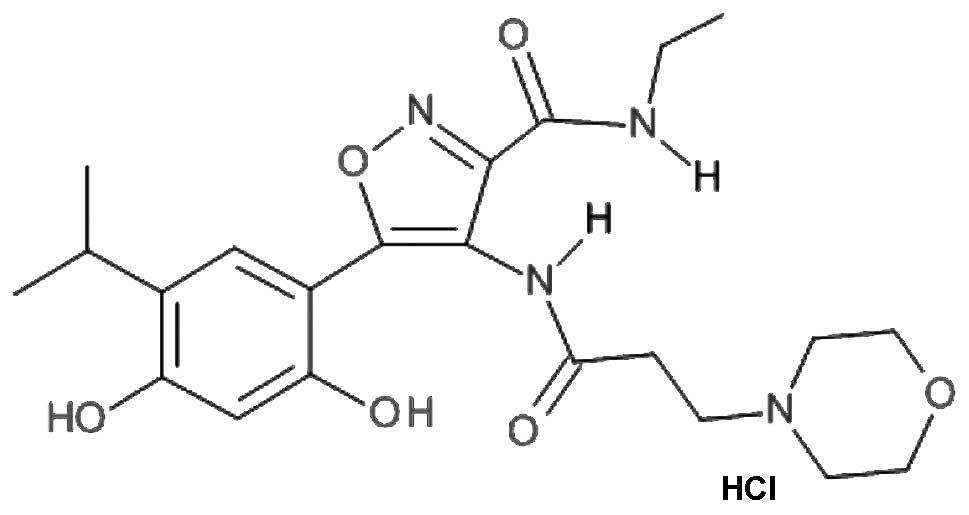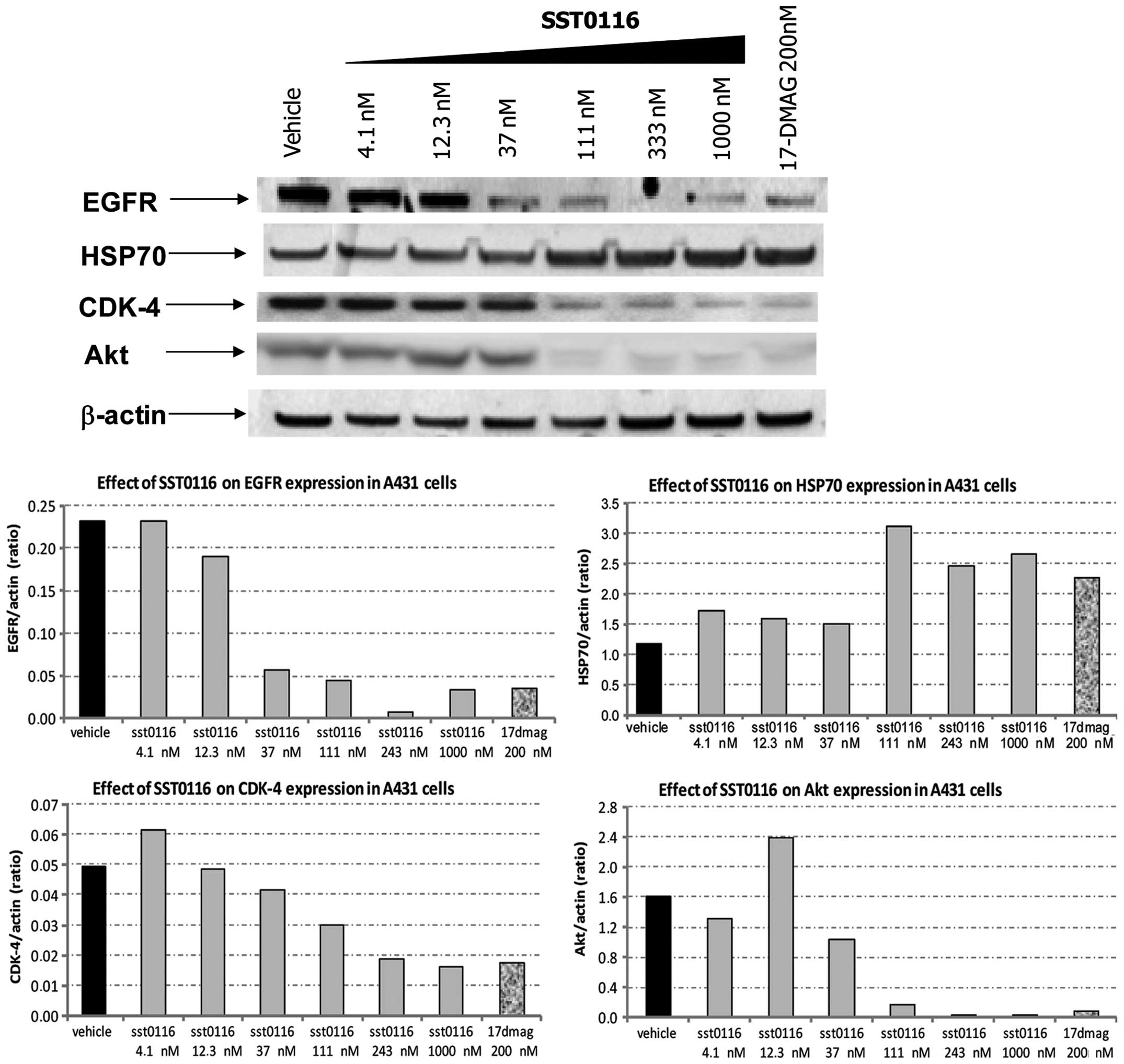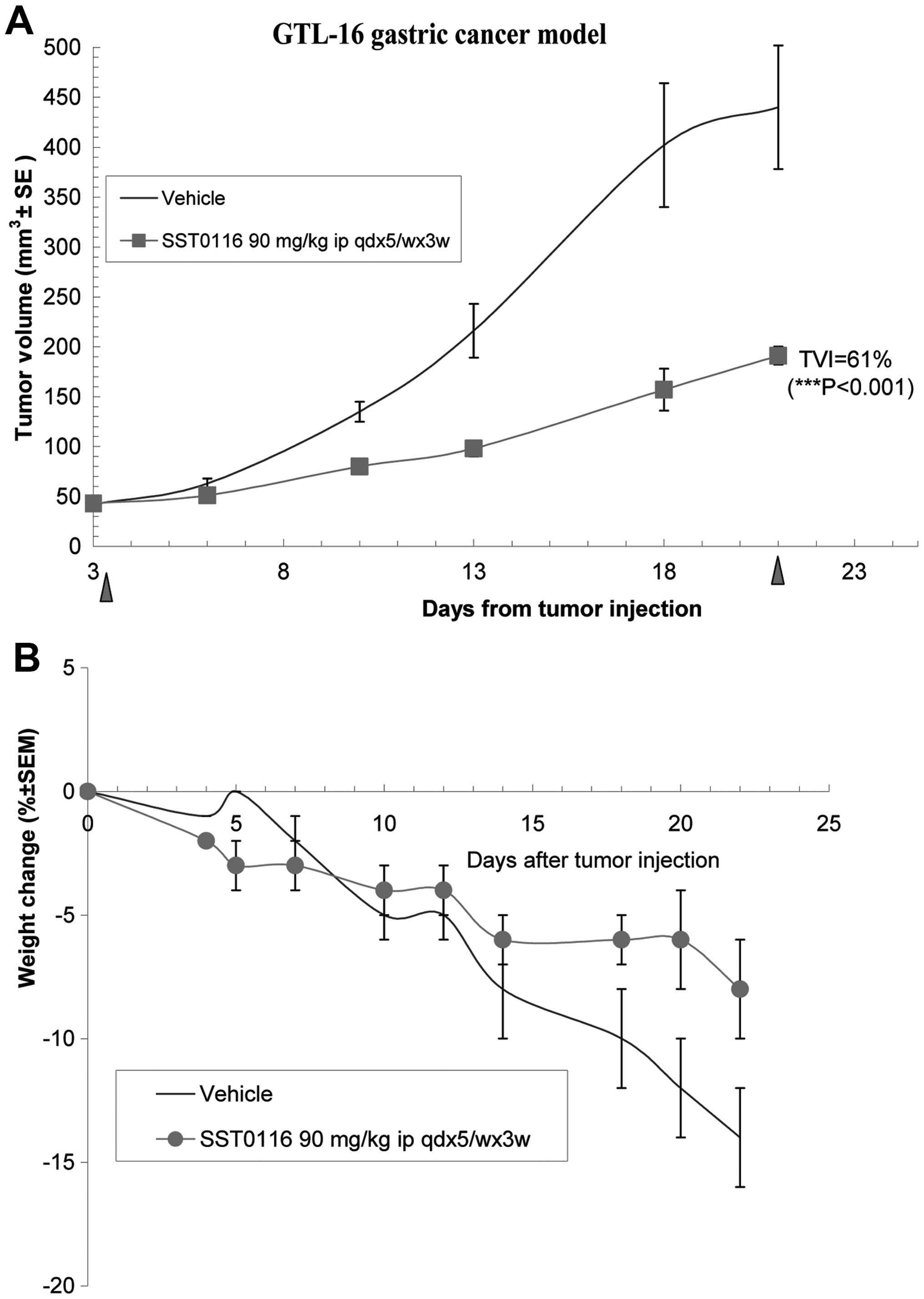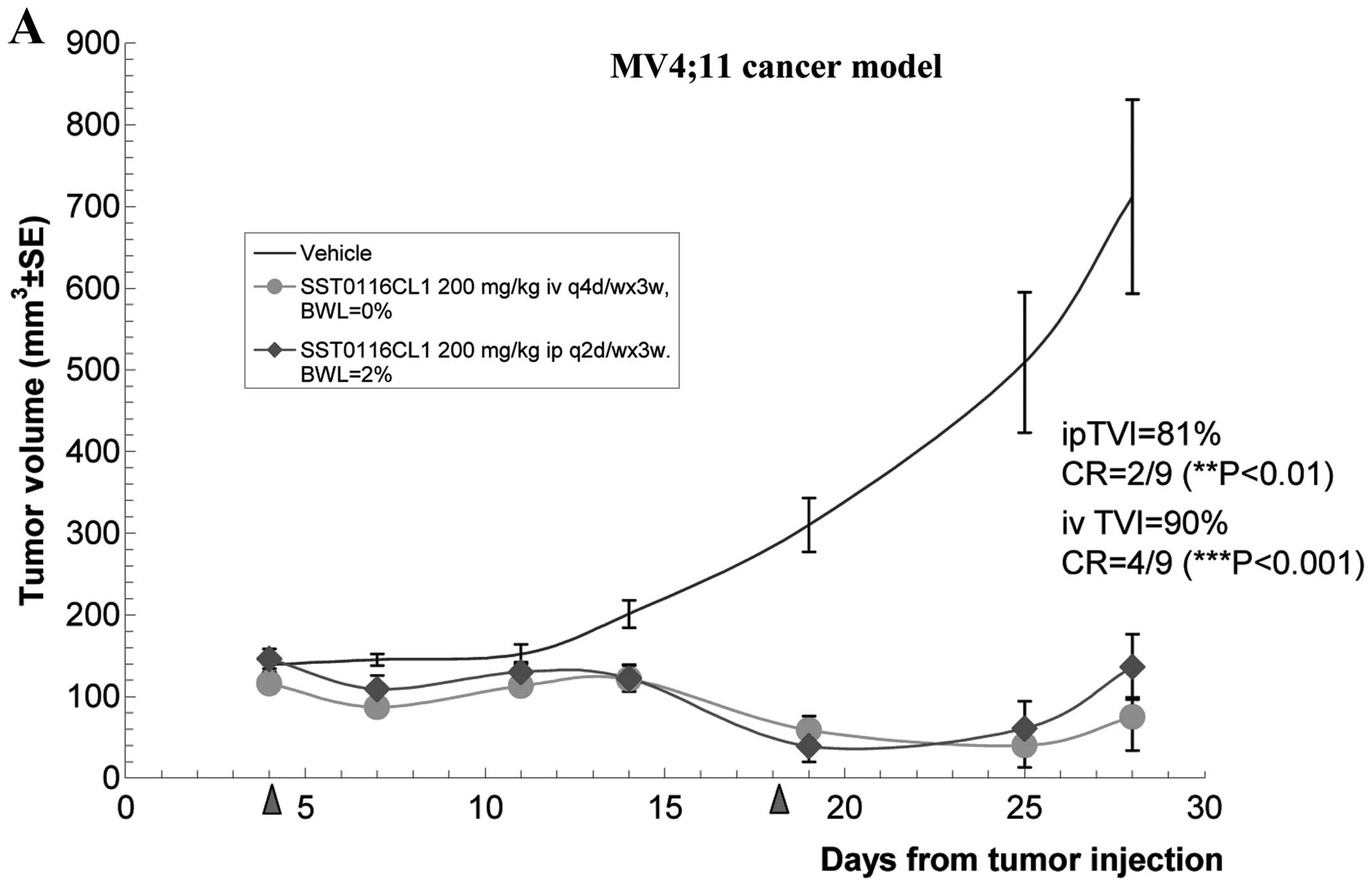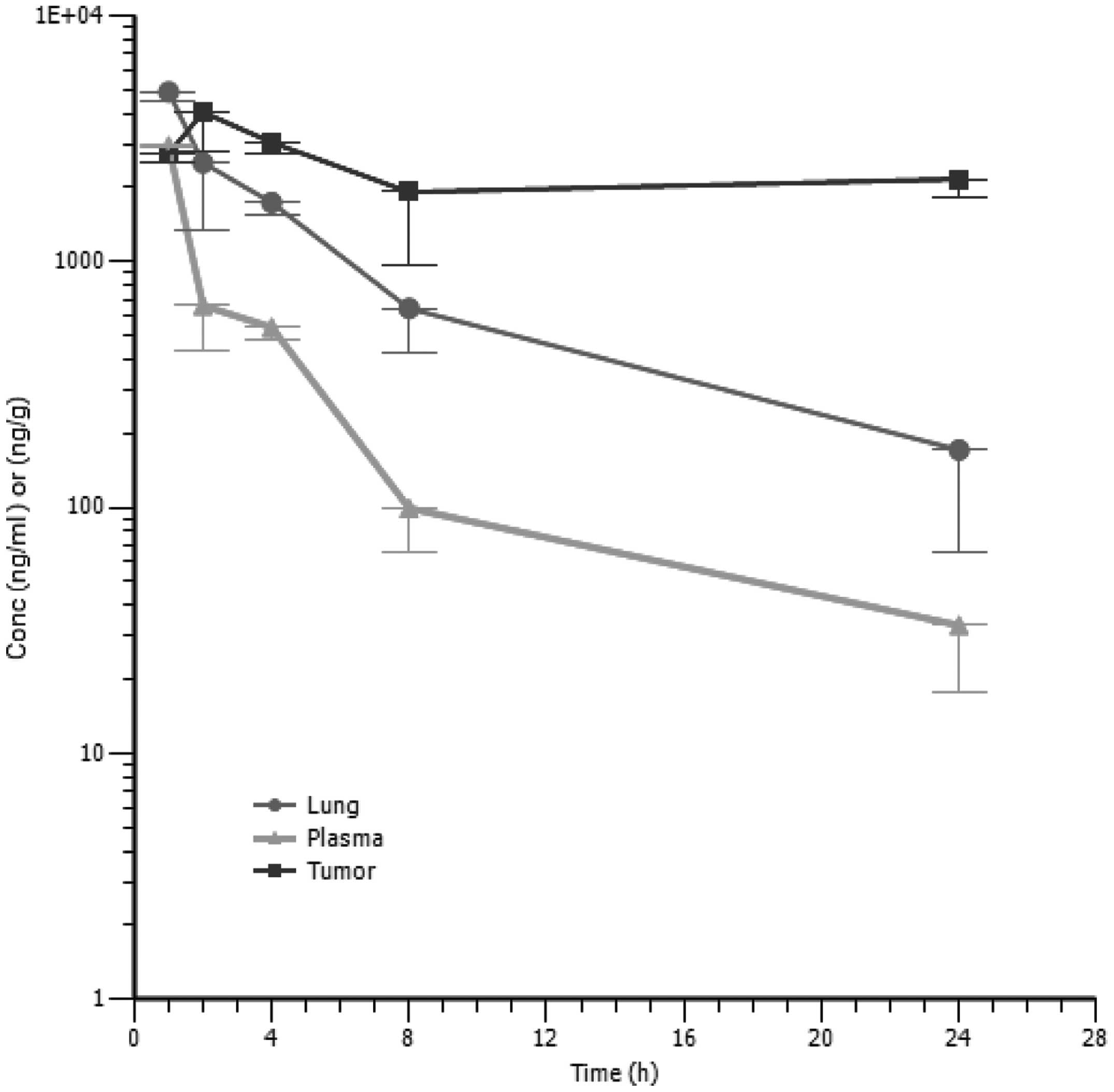|
1
|
Li J and Buchner J: Structure, function,
and regulation of the Hsp90 machinery. Biomed J. 36:106–117. 2013.
View Article : Google Scholar
|
|
2
|
Hao H, Naomoto Y, Bao X, Watanabe N,
Sakurama K, Noma K, Motoki T, Tomono Y, Fukazawa T, Shirakawa Y,
Yamatsuji T, Matsuoka J and Takaoka M: Hsp90 and its inhibitors.
Oncol Rep. 23:1483–1492. 2010.PubMed/NCBI
|
|
3
|
Whitesell L and Lindquist SL: HSP90 and
the chaperoning of cancer. Nat Rev Cancer. 5:761–772. 2005.
View Article : Google Scholar : PubMed/NCBI
|
|
4
|
Mahalingam D, Swords R, Carew JS, Nawrocki
ST, Bhalla K and Gilles FJ: Targeting HSP90 for cancer therapy. Br
J Cancer. 100:1523–1529. 2009. View Article : Google Scholar : PubMed/NCBI
|
|
5
|
Kim YS, Alarcon SV, Lee S, Lee MJ,
Giaccone G, Neckers L and Trepel JB: Update on Hsp90 inhibitors in
clinical trial. Curr Top Med Chem. 9:1479–1492. 2009. View Article : Google Scholar : PubMed/NCBI
|
|
6
|
Sessa C, Shapiro GI, Bhalla KN, Britten C,
Jacks KS, Mita M, Papadimitrakopoulou V, Pluard T, Samuel TA,
Akimov M, Quadt C, Fernandez-Ibarra C, Lu H, Bailey S, Chica S and
Banerji U: First-in-human phase I dose-escalation study of the
Hsp90 inhibitor AUY922 in patients with advanced solid tumors. Clin
Cancer Res. 19:3671–3680. 2013. View Article : Google Scholar : PubMed/NCBI
|
|
7
|
Goldman JW, Raju RN, Gordon GA, El-Hariry
I, Teofilivici F, Vukovic VM, Bradley R, Karol MD, Chen Y, Guo W,
Inoue T and Rosen LS: A first in human, safety, pharmacokinetics,
and clinical activity phase I study of once weekly administration
of the Hsp90 inhibitor ganetespib (STA-9090) in patients with solid
malignancies. Biomed Central Cancer. 13:152–161. 2013.
|
|
8
|
Soga S, Akinaga S and Shiotsu Y: Hsp90
inhibitors as anti-cancer agents, from basic discoveries to
clinical development. Curr Pharm Des. 19:366–376. 2013. View Article : Google Scholar : PubMed/NCBI
|
|
9
|
Li J, Soroka J and Buchner J: The Hsp90
chaperone machinery: conformational dynamics and regulation by
co-chaperons. Biochim Biophys Acta. 1823.624–635. 2012.PubMed/NCBI
|
|
10
|
Eccles SA, Massey A, Raynaud FI, Sharp SY,
Box G, Valenti M, Patterson L, de Haven Brandon A, Gowan S, Boxall
F, Aherne W, Rowlands M, Hayes A, Martins V, Urban F, Boxall K,
Prodromou C, Pearl L, James K, Matthews TP, Cheung KM, Kalusa A,
Jones K, McDonald E, Barril X, Brough PA, Cansfield JE, Dymock B,
Drysdale MJ, Finch H, Howes R, Hubbard RE, Surgenor A, Webb P, Wood
M, Wright L and Workman P: NVP-AUY922: a novel heat shock protein
90 inhibitor active against xenograft tumor growth, angiogenesis,
and metastasis. Cancer Res. 68:2850–2860. 2008. View Article : Google Scholar : PubMed/NCBI
|
|
11
|
Jensen MR, Schoepfer J, Radimerski T,
Massey A, Guy CT, Brueggen J, Quadt C, Buckler A, Cozens R,
Drysdale MJ, Garcia-Echeverria C and Chène P: NVP-AUY922: a small
molecule HSP90 inhibitor with potent antitumor activity in
preclinical breast cancer models. Breast Cancer Res. 10:R332008.
View Article : Google Scholar : PubMed/NCBI
|
|
12
|
Wang Y, Trepel JB, Neckers LM and Giaccone
G: STA-9090, a small-molecule Hsp90 inhibitor for the potential
treatment of cancer. Curr Opin Investig Drugs. 11:1466–1476.
2010.PubMed/NCBI
|
|
13
|
Okawa Y, Hideshima T, Steed P, Vallet S,
Hall S, Huang K, Rice J, Barabasz A, Foley B, Ikeda H, Raje N,
Kiziltepe T, Yasui H, Enatsu S and Anderson KC: SNX-2112, a
selective Hsp90 inhibitor, potently inhibits tumor cell growth,
angiogenesis, and osteoclastogenesis in multiple myeloma and other
hematologic tumors by abrogating signaling via Akt and ERK. Blood.
113:846–855. 2009. View Article : Google Scholar
|
|
14
|
Lin TY, Bear M, Du Z, Foley KP, Ying W,
Barsoum J and London C: The novel HSP90 inhibitor STA-9090 exhibits
activity against Kit-dependent and -independent malignant mast cell
tumors. Exp Hematol. 36:1266–1277. 2008. View Article : Google Scholar
|
|
15
|
Lundgren K, Zhang H, Brekken J, Huser N,
Powell RE, Timple N, Busch DJ, Neely L, Sensintaffar JL, Yang YC,
McKenzie A, Friedman J, Scannevin R, Kamal A, Hong K, Kasibhatla
SR, Boehm MF and Burrows FJ: BIIB021, an orally available, fully
synthetic small-molecule inhibitor of the heat shock protein Hsp90.
Mol Cancer Ther. 8:921–929. 2009. View Article : Google Scholar : PubMed/NCBI
|
|
16
|
Picard D: Heat shock protein 90, a
chaperone for folding and regulation. Cell Mol Life Sci.
59:1640–1648. 2002. View Article : Google Scholar : PubMed/NCBI
|
|
17
|
Baruchello R, Simoni D, Grisolia G,
Barbato G, Marchetti P, Rondanin R, Mangiola S, Giannini G,
Brunetti T, Alloatti D, Gallo G, Ciacci A, Vesci L, Castorina M,
Milazzo FM, Cervoni ML, Guglielmi MB, Barbarino M, Foderà R, Pisano
C and Cabri W: Novel 3.4-isoxazolediamides as potent inhibitors of
chaperone heat shock protein 90. J Med Chem. 54:8592–8604. 2011.
View Article : Google Scholar : PubMed/NCBI
|
|
18
|
Jhaveri K and Modi S: Hsp90 inhibitors for
cancer therapy and overcoming drug resistance. Adv Pharmacol.
65:471–517. 2012. View Article : Google Scholar : PubMed/NCBI
|
|
19
|
Patel HJ, Modi S, Chiosis G and Taldone T:
Advances in the discovery and development of heat-shock protein 90
inhibitors for cancer treatment. Expert Opin Drug Discov.
6:559–587. 2011. View Article : Google Scholar : PubMed/NCBI
|
|
20
|
Trepel J, Mollapour M, Giaccone G and
Neckers L: Targeting the dynamic Hsp90 complex in cancer. Nat Rev
Cancer. 10:537–549. 2010. View
Article : Google Scholar : PubMed/NCBI
|
|
21
|
Ramanathan RK and Egorin MJ, Eiseman JL,
Ramalingam S, Friedland D, Agarwala SS, Zuhowski EG, Lan J, Potter
DM, Ivy SP, Ramalingam S, Brufsky AM, Wong MK, Tutchko S and Egorin
MJ: Phase I and pharmacodynamic study of
17-(allylamino)-17-demethoxygenldanamycin in adult patients with
refractory advanced cancers. Clin Cancer Res. 13:1769–1774. 2007.
View Article : Google Scholar : PubMed/NCBI
|
|
22
|
Ramanathan RK, Egorin MJ, Erlichman C,
Remick SC, Ramalingam SS, Naret C, Holleran JL, TenEyck CJ, Ivy SP
and Belani CP: Phase I pharmacokinetic and pharmacodynamic study of
17-dimethylaminoethylamino-17-demethoxygeldanamycin, an inhibitor
of heat-shock protein 90, in patients with advanced solid tumors. J
Clin Oncol. 28:1520–1526. 2010. View Article : Google Scholar : PubMed/NCBI
|
|
23
|
Mimnaugh EG, Chavany C and Neckers L:
Polyubiquitination and proteasomal degradation of the p185c-erbB-2
receptor protein-tyrosine kinase induced by geldanamycin. J Biol
Chem. 271:22796–22801. 1996. View Article : Google Scholar : PubMed/NCBI
|
|
24
|
Christensen JG, Schreck R, Burrows J,
Kuruganti P, Chan E, Le P, Chen J, Wang X, Ruslim L, Blake R,
Lipson KE, Ramphal J, Do S, Cui JJ, Cherrington JM and Mendel DB: A
selective small molecule inhibitor of c-Met kinase inhibits
c-Met-dependent phenotypes in vitro and exhibits cytoreductive
antitumor activity in vivo. Cancer Res. 63:7345–7355.
2003.PubMed/NCBI
|
|
25
|
Gilliland DG and Griffin JD: Role of FLT3
in leukemia. Curr Opin Hematol. 9:274–281. 2002. View Article : Google Scholar : PubMed/NCBI
|
|
26
|
Lopes de Menezes DE, Peng J, Garrett EN,
Louie SG, Lee SH, Wiesmann M, Tang Y, Shephard L, Goldbeck C, Oei
Y, Ye H, Aukerman SL and Heise C: CHIR-258: a potent inhibitor of
FLT3 kinase in experimental tumor xenograft model of human acute
myelogenous leukemia. Clin Cancer Res. 11:5281–5291.
2005.PubMed/NCBI
|
|
27
|
Fathi AT and Chabner BA: FLT3 inhibition
as therapy in acute myeloid leukemia: a record of trials and
tribulations. Oncologist. 16:1162–1174. 2011. View Article : Google Scholar : PubMed/NCBI
|
|
28
|
Gottesman MM, Bates SE and Fojo T:
Multidrug resistance in cancer: role of ATP-dependent transporters.
Nat Rev Cancer. 2:48–58. 2002. View
Article : Google Scholar : PubMed/NCBI
|
|
29
|
McCollum AK, TenEyck CJ, Stensgard B,
Morlan BW, Ballman KV, Jenkins RB, Toft DO and Erlichman C:
P-glycoprotein mediated resistance to Hsp90-directed therapy is
eclipsed by the heat shock response. Cancer Res. 68:7419–7427.
2008. View Article : Google Scholar : PubMed/NCBI
|
|
30
|
Banerji U, O’Donnell A, Scurr M, Pacey S,
Stapleton S, Asad Y, Simmons L, Maloney A, Raynaud F, Campbell M,
Walton M, Lakhani S, Kaye S, Workman P and Judson I: Phase I
pharmacokinetic and pharmacodynamic study of 17-allylamino,
17-demethoxygeldanamycin in patients with advanced malignancies. J
Clin Oncol. 23:4152–4161. 2005. View Article : Google Scholar : PubMed/NCBI
|
|
31
|
Kelland LR, Sharp SY, Rogers PM, Myers TG
and Workman P: DT Diaphorase expression and tumor cell sensitivity
to 17-allylamino, 17-demethoxygeldanamycin, an inhibitor of heat
shock protein 90. J Natl Cancer Inst. 91:1940–1949. 1999.
View Article : Google Scholar : PubMed/NCBI
|
|
32
|
Hostein I, Robertson D, DiStefano F,
Workman P and Clarke PA: Inhibition of signal transduction by the
Hsp90 inhibitor 17-allylamino-17-demethoxygeldanamycin results in
cytostasis and apoptosis. Cancer Res. 61:4003–4009. 2001.PubMed/NCBI
|
|
33
|
Ellis LM and Hicklin DJ: Resistance to
targeted therapies: refining anticancer therapy in the era of
molecular oncology. Clin Cancer Res. 15:7471–7478. 2009. View Article : Google Scholar : PubMed/NCBI
|



